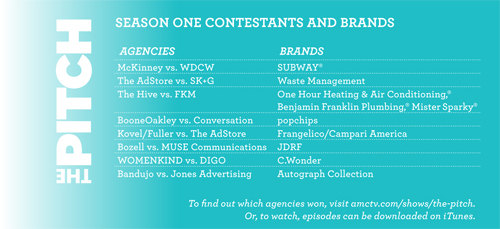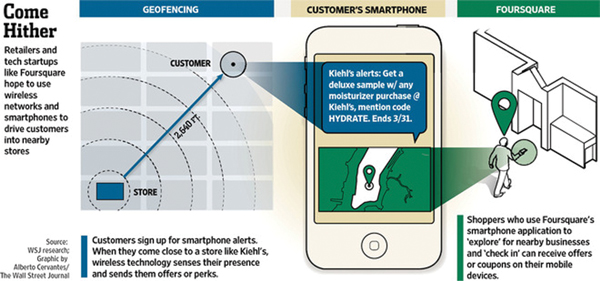October 12th, 2012
Location, Location, Location
Location-based marketing is on the rise.
With smartphone adoption and usage on the rise, the percentage of people using their phones to find local information is increasing dramatically. In fact, a recent study by Pew Research Center found that nearly three quarters of smartphone owners accessed location-based services (LBSs).
The most well known LBS is Foursquare, which has more than 10 million users. But, because of the growing demand for more hyper-local information, as well as more marketing options that reach consumers, LBSs are rapidly moving beyond check-ins. Several mobile apps, like the Weather Channel and Pandora, are now offering location-based ad options.
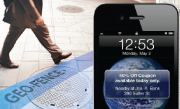 If you are a marketer, one LBS application worth learning more about is geo-fencing.1 From a marketing standpoint, geo-fencing refers to setting up a digital perimeter around a physical place (i.e., a store or shopping area). The crossing of the digital geo-fence by a consumer with a smartphone triggers a marketing offer, such as a coupon or other special offer.
If you are a marketer, one LBS application worth learning more about is geo-fencing.1 From a marketing standpoint, geo-fencing refers to setting up a digital perimeter around a physical place (i.e., a store or shopping area). The crossing of the digital geo-fence by a consumer with a smartphone triggers a marketing offer, such as a coupon or other special offer.
With mobile apps, consumers don’t have to check into a location to receive a LBS ad, but they do have to open an app to see one. Geo-fencing sidesteps that. After the consumer completes an initial opt-in (usually through a third-party operating the geo-fence for a brand) all that’s required to participate is for the phone to be turned on in order for a marketer to target someone with a local ad. Imagine walking into the grocery store and getting a coupon for Pepsi or Wheaties, or into Home Depot and getting an offer for $5 off $25 spent, or into Kohl’s and getting a 15-percent-off coupon.
Many retailers are already using geo-fencing (also referred to as proximity marketing) to fight showrooming—the trend of visiting a store to view or try on the product in person, but then going online to purchase the item at a lower cost. Placecast’s ShopAlerts program has more than 10 million registered users and more than 130 companies that have used their platform to run marketing programs, including Kohl’s and Subway. North Face has been using geo-fences since 2010—not only around its stores, but also around parks and ski resorts to deliver snow reports to skiers on their way to the slopes.
Geo-fencing has been around for some time, but it hasn’t gained a lot of momentum. However, that is changing and it is going to become very real over the next few years. The reasons are:
- Smartphone usage has become mainstream
- Geo-fencing technology has matured and dropped in price
- Location-based ad targeting is getting more sophisticated and accurate
- Consumers are more accepting of geo-targeted advertising
Location-based technology will have a major impact on marketing and will redefine behavioral targeting. Marketers have always wanted to be in the right place, at the right time, with the right messaging. And, with the ever advancing nature of technology, as well as the advancements in location-based marketing, we are getting closer each day.
To read more about geo-fencing and other LBSs, check out http://bozell.com/lbs.
October 12th, 2012
I'm on Facebook, therefore I'm social?
Being on social media vs. being a social business.
Being active in social media can be a good thing for your business, but it does not equate to a business being social. Honestly, it’s not even a prerequisite. In fact, there is currently a debate about what constitutes a “social” business, because each one looks different. For the purpose of this article, I offer a few definitions.
Social media are online and mobile platforms that allow large-scale conversations. Facebook and Twitter are popular social media platforms today.
A social enterprise, not to be confused with a social business, is a business focused on social good. Jamie Oliver’s Fifteen, a chef training program for disadvantaged young adults, is a clear example (www.fifteen.net).
A social business, however, is about engaging all constituents to fuel and implement corporate and product change and success. Google and Lowe’s currently implement successful social business frameworks.
Companies implementing a social business framework feel that change comes from the people and processes they are part of. This means ALL people (employees, leadership, owners, partners, suppliers, customers, etc.) are vital pieces of how businesses grow and achieve success. When all voices are valued, systems and technology are in place to help foster a collaborative environment and culture that leads to a more responsive, adaptable and effective company. Real-time conversation, feedback, decision-making and change are helping some companies excel. At the same time, being a social business means starting internally and does not necessarily translate to external efforts – at least not initially.
Information and idea sharing has become critical for current and future success – businesses are staying on top of innovation and customers now expect to be heard. But there are various levels of social business that can be implemented, and no single correct way or template to follow. However, the first step is to understand its importance.
There are five compelling reasons companies should consider becoming social.
- Customers now expect seamless communication with companies and brands. They value personal relationships and immediate-response channels.
- Technology has evolved to make social endeavors possible and affordable.
- Successful companies today have social values in the core of their organization.
- Social approaches can offer large workplace efficiencies when feedback and decision-making processes are streamlined.
- The incoming and subsequent workforces are social and expect the workplace to be collaborative and empowering.
Becoming social is not necessarily an easy goal and can take time to achieve. Every social business looks different, but they all start internally. How to get there involves:
- Having a company vision that connects social goals with overall goals.
- Implementing a corporate mindset of collaboration and subsequent change.
- Designing a faster information flow and distributed decision-making process. Making sure the right people are in place to implement.
- Evaluating any current social strategies and integrating them into the process or procedure is valuable.
- Committing infrastructure and tools to support fluid communication.
- Evaluating current technology and ensuring integration and ease of use before augmenting with additional tools.
- Ensuring all participants are trained and prepared for a social environment.
Ultimately, it’s not all about conversation and information. A social environment requires some filtering. Guidelines become critical for all involved, helping the flow of information and response process. Without filtering and guidelines, people can actually feel overwhelmed with information and no longer participate, thus undermining the intent of a social business.
Is a social business right for you? It depends on business goals. We know successful companies are social. At the same time, social business does not start with the customer. The business itself, the internal workings, culture and communications must be social before including customers in the process through opportunities such as Facebook.
Thank you to SideraWorks, IBM, and the Social Business Forum for sharing their knowledge to inform our thinking.
October 12th, 2012
Pawing Away at the Competition
An insider’s perspective on the pet industry.
Few industries experience recessionary growth. Alcohol and gambling always do well, but, during the current recession, we also see that pet care and product spending is steady. While pet owners may have scaled down spending during the recession, they still find the money to pamper their pets. With 62 percent of U.S. households owning pets and spending a projected $52.87 billion cumulatively for 2012, the category has continued to expand nationwide.
Recently Bozell met up with Soggy Paws—a retail business that features self-wash stations for dogs and high-quality food and toys. Soggy Paws focuses on exceptional customer service and a deep knowledge of dogs and their nutritional needs. The stores also have a cat-focused section. The business has grown from an entrepreneurial start-up to four locations in Chicago and one in Omaha.
Bozell asked the co-owners of Soggy Paws to share their perspectives on the pet industry, their business and some of the challenges they have faced. The following is a transcript of the interview with Soggy Paws’ Paul Rathe and Kevin Richardson.
Please start by sharing a little history. How did the Soggy Paws idea start?
RICHARDSON: In 2004, the dog market was ready for a middle price point. It’s a very fragmented market with a lot of opportunity. Our first location was decided purely through market research.How did you market the first store?
RATHE: We tried a lot of things. We did direct mail, placed ads in the paper, and became members of the local Chambers of Commerce.Recently Soggy Paws opened an Omaha location. What have been the unique challenges for this store, compared with the Chicago stores?
RICHARDSON: No one knowing who we were, or the concept, was the first obstacle. Omaha is today where Chicago was in 2004. There is a lot of education about pets that is happening. It feels a little like starting over. We are building a market all over again.What have been the marketing successes?
RICHARDSON: Relationship marketing or event marketing, like “Yappy Hours” and events with local rescues. Social marketing has worked really well, too.RATHE: Omaha has been great on Facebook. People are so much more active and responsive.
Pets seem to be a recession-proof industry. Would you agree?
RATHE: Yes, things just got put off a bit. People waited longer in between washes for their dogs. We also saw an uptick in new customers the day before a holiday. People also started downgrading their food – still buying premium brands but adjusting their level of spending.If you knew then what you know now, what would you have done differently?
RATHE: I think we would have spent the money to be in a more expensive place with more guaranteed traffic instead of being the pioneers in a neighborhood.RICHARDSON: If I knew where the economy was going, I would have franchised right away.
What would you say to someone considering opening a pet-focused business right now?
RICHARDSON: Don’t do it because you love dogs or you will get burned out. Maybe 10 percent of your day is getting to play with dogs. Hire smart people and let them make decisions, knowing that sometimes you will have to talk about how to make better decisions in the future. Also, realize you need to know what you are about. Every time something comes up [like a problem], if we go back to what we’re about, we’re okay.
Soggy Paws shared with Bozell how they continue to evolve their business as the market and economy change. And the takeaway is that no business is safe from the recession. You have to constantly adapt to your environment – economy, customer needs and wants, etc. Marketing is just as important. While having marketing efforts during economically leaner times can seem financially daunting for smaller companies, it can be just what you need to stay on track and be successful in the highly competitive pet industry.
Bozell has a great deal of knowledge and experience in the pet marketing segment. To learn more, email petlovers@bozell.com.
October 12th, 2012
The Problem Solving Problems
Finding a solution that’s right rather than perfect.
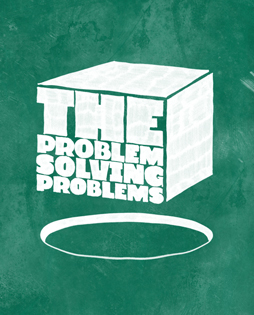 It is quite ironic that problem solving is such a problem in and of itself. Big or small, business or personal, not a day in our life passes when we are not presented with some sort of problem to solve. And no matter the type, there is one thing in common with every problem out there – the desire for a solution.
It is quite ironic that problem solving is such a problem in and of itself. Big or small, business or personal, not a day in our life passes when we are not presented with some sort of problem to solve. And no matter the type, there is one thing in common with every problem out there – the desire for a solution.
“We can’t solve problems by using the same kind of thinking we used when we created them.” These wise words were spoken by Albert Einstein and represent the first hurdle we face when it comes to solving problems. I have seen it time and time again: when people try to solve problems, the solution they come up with usually makes things harder than they were before. You’ve probably experienced this yourself. Let’s say there is a problem with an internal form in your organization. What is the solution to this problem, more often than not? Another form that you need to fill out before or after that form.
The form-upon-form problem illustrates the first mistake we make when we try to solve problems. Problems are like onions, they are layered. Under every problem is often another problem, and another below that. More often than not, we are not attempting to solve the correct problem. Ask yourself, and your team, “Why are we trying to solve this problem?” When given justification, ask “Why is this a problem?” On the surface this may seem silly and circular, but if you or your team cannot reasonably justify the root of the problem, then you are trying to solve the wrong problem.
Once our true problem is discovered, we’re ready to find a solution. The right solution. This is the hard part. For every problem there are endless solutions. Many are bad, some are good, fewer are great and one is the best. Do not be fooled by what seems to be the perfect solution, though, for it is almost never the right solution for the problem. This may seem ludicrous, but the “perfect” solution is often unattainable for many reasons – time, money, manpower and politics to name a few. It oftentimes has too many hurdles and roadblocks. You will become paralyzed and all progress will stagnate trying to implement it.
 Instead of fixating on the perfect solution, focus your attention on the good and great ones. The right solution will address as many aspects of the original problem as possible while also being the easiest overall to implement. This will likely mean that there will be some compromise. Accept that problem solving is a never-ending cycle. Your solution will inevitably introduce new problems or fail to address some aspects of the issue fully. Do not consider these perceived shortcomings as failures. On the contrary, they are expected side effects of the process. Remember, the perfect solution is usually unattainable.
Instead of fixating on the perfect solution, focus your attention on the good and great ones. The right solution will address as many aspects of the original problem as possible while also being the easiest overall to implement. This will likely mean that there will be some compromise. Accept that problem solving is a never-ending cycle. Your solution will inevitably introduce new problems or fail to address some aspects of the issue fully. Do not consider these perceived shortcomings as failures. On the contrary, they are expected side effects of the process. Remember, the perfect solution is usually unattainable.
Stephen Covey, the author of The Seven Habits of Highly Effective People, once said “The way we see the problem is the problem.” You have to establish the right problem. Then remember that problem solving is a continuous cycle. There is no end. Some of your solutions will succeed, others will fail. Even the good solutions will reach a point where they are no longer effective. Accept this and embrace the cycle. Do the best you can at that very moment with what you have, and then take all the experience and knowledge you’ve gained and do better with it the next time. And, without a doubt, there will be a next time.
August 16th, 2012
Innovation on Display
The reinvention of online display advertising.
Display advertising has been a part of our online world since 1994. However, it is overdue for a re-innovation. The boxes and rectangles that currently fill publisher’s sites desperately need an update.
Almost five trillion display ads were served last year, but brand campaign advertisers are yearning for more options and want to know whether or not money invested in the current ads is actually moving the needle.
The simple answer is yes. A well-executed display campaign can provide the first point of contact between a new customer and your company. While users may not click on it, the advertisement can create brand familiarity, awareness and, dare I say, generate search intent for when they are in a buying mode. But display advertising is only one way a brand can reach potential customers online.
Social media has already surpassed search in paid advertising. According to the latest edition of a quarterly survey of U.S. advertising agencies, social media is poised to overtake online display advertising as the number one source of digital media planning and buying. This is likely due to folks spending a large portion of their browsing time on these social sites.
All over the internet you will find new social media advertising platforms that have broken from the traditional display boxes. For example, Facebook set precedence with its noninvasive advertising platform and is now launching a new mobile ad platform. Twitter also broke away from tradition by using promotional tweets, and Pinterest has now hired the innovator behind Facebook’s platform to help create one that will best fit them.
Some publishers are offering what is known as native advertising, which is advertising that integrates seamlessly within a user’s experience. These ads run within the editorial of the site and are often paired with an advertiser’s sponsored content. If done right, native ads can be highly valuable and effective. That is, as long as they aren’t
blatant advertisements.
Another big change you can expect soon comes from the Interactive Advertising Bureau (IAB). Rising Stars is a component of the IAB initiative “Reimagining Interactive Advertising,” and is changing the way we advertise online. Basically, this ad unit, which will be referred to as the IAB Standard Ad Unit, will offer new ad formats that will be more eye-catching and more interactive than traditional ads.
The new sizes and formats that social media and the IAB bring to the table represent a start to the reinvention of display advertising and a hint at what we can expect to see in the future. Ads will look less like advertisements and advertisers will have more space for storytelling, as well as content that offers true engagement. Online advertising will only become more effective over the years, allowing advertisers to attain a better online presence, visibility and retention with their audiences.
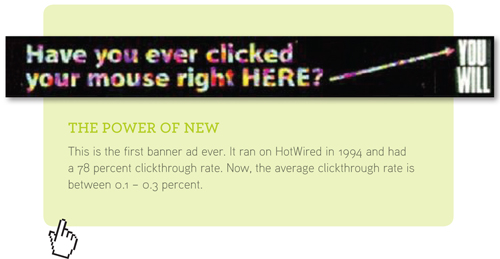
August 16th, 2012
The QR Decoder
The not-so-secret Secret behind QR Codes.
QR codes (short for quick response codes) are popping up everywhere. In the last 12 months, there has been a mountain of buzz surrounding them, and a hockey-stick growth rate on usage. One report put QR code activity up 314 percent from the first quarter of 2011 to the first quarter of 2012. And, everyday, more marketers are including them as a standard part of their marketing plans.
Why?
Because mobile marketing is the fastest growing area of marketing.
The mobile phone is the most ubiquitous device out there. And because more than half of all Americans are now smartphone users, it’s where your customers are accessing information about your products and services. By 2014, ComScore expects more people to access the Web via smartphones than by desktops or laptops, so QR codes are a perfect tool.
Here are just a few reasons to start using QR codes:
- One in five U.S. smartphone users scanned a QR code in a retail store in 2011.
- One third of consumers younger than 40 years old use QR codes at least a couple of times per month.
- One third of QR code scanners did so in response to a coupon or offer.
- One quarter of QR code scanners did so to receive information on an event.
 QR codes are an easy-to-use, low-cost way to engage and activate mobile users for any company, large or small. But keep in mind that, while it’s easy to create and throw a QR code out into the market, creating a great online experience that encourages repeat use is much more difficult. The fact is, the content beyond your QR code is arguably the most critical element of success in code usage.
QR codes are an easy-to-use, low-cost way to engage and activate mobile users for any company, large or small. But keep in mind that, while it’s easy to create and throw a QR code out into the market, creating a great online experience that encourages repeat use is much more difficult. The fact is, the content beyond your QR code is arguably the most critical element of success in code usage.
Here are some basic QR code content guidelines:
- Make the destination mobile friendly. Many people don’t do this and it creates a bad experience.
- Use video and motion graphics where possible.
- Apply best practices. The code should be at least a
- 1” x 1” square, with sufficient white space around it.
- Make sure your code isn’t too complex so it can be adequately read by the average smartphone. If the URL is too long or you’ve included Google tracking tags, use a URL that’s shorter to improve the readability of the code.
- Try to ensure the code’s location is mobile accessible. Don’t use QR codes in the subway, on high billboards or in places where it is hard to scan.
- Don’t assume a user gets it. Explain how to use the code and where it will take them.
- Provide details on how people can scan your code if they are not familiar. And give them links to download a code reader.
The beauty of QR codes is their flexibility and trackability. Through stats, you can understand more about your customers in order to develop better campaigns. You can change the destination of a QR code at any point. Or even do A/B testing. The possibilities are endless and it’s a great way to get into mobile marketing right now.
Whether you love or hate QR codes, they’re becoming progressively more present and useful as they mature from hype to the frontline of marketing. And, as a mobile engagement technique, they are something you can and should put to use today.
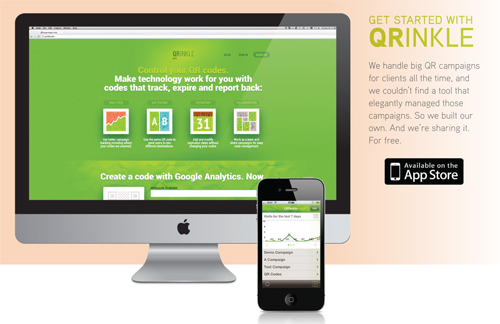
August 16th, 2012
Unplug or Cut the Cord
What’s causing the consumer disconnect?
There are two parallel, culture-changing trends making news right now: “unplugging” and “cutting the cord.” These oft-interchanged labels describe a trend of consumers shifting (consciously or not) how they access TV, cable TV and mobile information in our wired, interconnected world. There are even online support groups for people trying to leave this technology behind.
Cutting the Cord
Cord-cutters are those changing how they watch cable TV programming and, in some cases, are abandoning the tube altogether. College students are comfortable watching programming on a variety of non-traditional devices and are spearheading the change. Almost half of U.S. households watch video on their computers, and, among college students, 91 percent watch video on their laptops.  Nielsen predicts that 3.58 million Americans will cut their TV cords by the end of the year, and the number of households with a TV is slowly declining. However, those still connected to their living room screens aren’t likely to give up cable anytime soon. Instead, we are seeing cultural change around when and how people watch TV programming.
Nielsen predicts that 3.58 million Americans will cut their TV cords by the end of the year, and the number of households with a TV is slowly declining. However, those still connected to their living room screens aren’t likely to give up cable anytime soon. Instead, we are seeing cultural change around when and how people watch TV programming.
Get Unplugged
Nearly half of U.S. adults have a smartphone (46 percent), and the number is predicted to continue growing, according to PEW. The number of smartphone users is now higher than users of basic mobile phones. In addition, the number of tablet users is increasing. Smartphones and tablets have eliminated the concept of having “spare time” as users constantly pull out their devices to multitask. Standing in line is an opportunity to check email, catch up on social media or watch a video. We have become a very connected society, and sometimes it’s hard to unplug.
Even on vacation, only about six percent of people can actually unplug themselves. The rest of us experience disconnection anxiety. We can’t truly relax until we’ve cleared out an inbox or made sure nothing critical is happening.
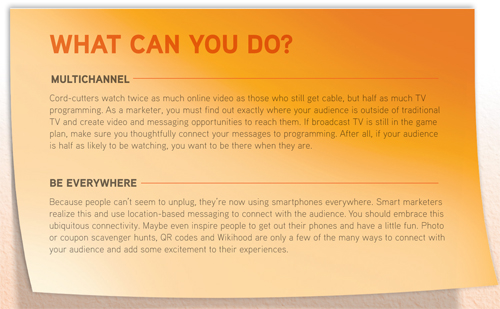
August 16th, 2012
Rock On, Sales, Rock On
Leveraging Bozell Smartargeting™ to help increase business.
One of the hardest things to do during a recession, even on the incline, is to convince a company that they should advertise. It’s no surprise that one of the first things cut from the budget is marketing and advertising. But Bozell’s recent work with Varco Pruden Buildings (VP) proved that if you advertise wisely, you can spend a little and make a lot.
The Client
VP is a world leader in the pre-engineered steel construction industry. Each year, VP manufactures more than 6,000 buildings, ranging from 1,200 square feet to more than one million square feet. These buildings are assembled by a network of more than 1,000 independent Authorized VP Builders in local communities throughout the United States and Canada, as well as Central and South America, Europe and Asia.
The Challenge
The first quarter of the calendar year is typically the best time for VP to recruit new builders. The builders are gearing up for the peak season and are always looking to grow and expand. For the most successful builders, working with a trusted, service-oriented and reputable supplier is a primary key to their success. The challenge was to find “cream of the crop” builders that value a quality relationship and product, as VP is not the lowest-priced supplier in the category.
 The Strategy
The Strategy
Enter Smartargeting, Bozell’s direct marketing division. Bozell Smartargeting uses the most advanced databases and market-segmentation software available, creating customized lists for effective and efficient direct response campaigns.
First, Bozell worked closely with VP to create the profile of what were labeled Tier I, Tier II and Tier III builders. This was based on profiling their existing Authorized VP Builders with factors such as annual sales, years in business, number of employees, market coverage, single versus multiple locations, etc.
Next, a sophisticated market share analysis was performed on every county across the United States. Using market penetration models and building statistics, Bozell identified specific counties in which VP has the best potential for market penetration and growth. From there, the Tier I, II and III profiles were layered over all builders in the identified markets in order to extract the prospect list.
The Execution
Direct mail was identified as the most effective tactic, due to demographic characteristics of the targeted builders. Based on the target audience (35- to 55-year-old men) and understanding VP’s brand positioning, Bozell came up with the “VP Rocks” concept.
This campaign tapped into the 70s rock music era that the target audience grew up listening to. The mock album covers and turntable artwork helped to set a nostalgic tone for VP – one that is relatable to the days when a handshake meant you could trust someone’s word.
Because some of the target audience is more technologically savvy than others, Bozell offered three ways for these builders to contact VP: 1) A telephone number; 2) A mail-in response card; 3) A micro-site that was accessible by either a Web address or a flash drive that auto-launched the site. A four-digit code was also provided for each recipient. This allowed their contact information to automatically populate, as well as be linked to the original database, so it could be emailed to the appropriate territory manager for immediate follow-up.
 The Results
The Results
The campaign launched in early March 2012 and consisted of two waves of direct mail to the three tiers identified. To date, VP has received more than 60 replies. Based on the builder profiles, the annual revenue generated per builder is projected to be between $750,000 and $1 million. This puts the potential incremental revenue for this recruiting effort currently in the range of $45-60 million annually.
For a relatively modest budget, Bozell helped VP maximize the ROI for this initiative through both smart, strategic thinking and attention-grabbing executions. All of which aligned perfectly with the VP brand as a trusted sage and innovative leader in the industry.
August 16th, 2012
To Pitch or Not to Pitch?
Bozell’s behind the scenes of AMC’s The Pitch.
The Pitch is AMC’s new original docu-series where two advertising agencies go head-to-head to compete for a piece of real business. Of the 26,000 agencies in the world, Bozell was one of 15 agencies chosen to participate.
Bozell’s main concern with doing the show was that the agency would not be portrayed accurately. Without control of the final edit, there were no guarantees. But Studio Lambert, the show’s producer and creator of CBS’s Undercover Boss, helped convince the managing partners that they would merely document behind-the-scenes agency activity. After much trepidation, the partners decided, win or lose, this would be a good opportunity to show the rest of the country that smart, creative thinking is alive and well in the Midwest.
The client, we were told, was JDRF and we couldn’t have been happier. We had not only worked with JDRF’s Omaha chapter in the past, but each year Bozell donates time and talent to charitable organizations – all part of founder Morris Jacobs’ belief that we should all “pay rent for the space that we occupy on this earth.” So the stage was set and in less than a week we were on our way to New York City to receive the brief from JDRF.
Our Competition
Muse Communications from Los Angeles.Our Assignment
Create a campaign that enhances awareness of type 1 diabetes, establish it in the public eye as a serious, chronic disease that affects people of all ages, and increase awareness of JDRF as the organization dedicated to type 1 diabetes.
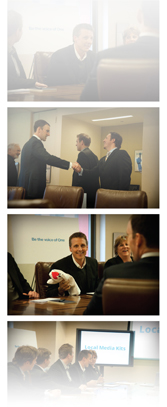 Typically, we would come up with several concepts to present, as many of the other agencies that appeared on the program did, but JDRF specifically asked us to come back with one buzz-creating idea that utilized non-traditional media. The budget was tight and so was our timeline – just the kind of pressure on which we thrive.
Typically, we would come up with several concepts to present, as many of the other agencies that appeared on the program did, but JDRF specifically asked us to come back with one buzz-creating idea that utilized non-traditional media. The budget was tight and so was our timeline – just the kind of pressure on which we thrive.
For the next 10 days, cameras followed us everywhere, recording our discussions, debates, arguments and overall ideation. Some of us were even filmed at home, in restaurants and at church. Specific creative teams were selected to come up with concepts with guidance from our social media and digital departments. The accelerated timeline and ever-present film crew kept us on our toes, and the “big idea” had to be determined quickly. After two days, we settled on one idea and began fleshing out presentation materials, including online banner ads, video storyboards, website mockups, an anthem video with original music, and a stunt to be staged outside JDRF headquarters the morning of our pitch.
As you may have already seen, after presenting our big idea, JDRF selected our campaign for its originality and smart use of digital and social media.
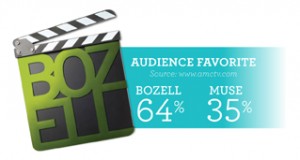 Our experience on The Pitch was a great one. Several of the big agencies declined AMC’s offer to be on the show, claiming it might reveal their “secret sauce.” The real secret, though, is that there is no secret sauce. Great advertising is about smart, talented people coming together to turn insights into creative marketing solutions that influence people to try and trust a brand. The real risk agencies faced by appearing on The Pitch was losing on national television. Fortunately for us, that wasn’t the case. But, even if we had lost, knowing that for one hour we helped shed light on JDRF’s fight to end type 1 diabetes is something we would have always considered a win.
Our experience on The Pitch was a great one. Several of the big agencies declined AMC’s offer to be on the show, claiming it might reveal their “secret sauce.” The real secret, though, is that there is no secret sauce. Great advertising is about smart, talented people coming together to turn insights into creative marketing solutions that influence people to try and trust a brand. The real risk agencies faced by appearing on The Pitch was losing on national television. Fortunately for us, that wasn’t the case. But, even if we had lost, knowing that for one hour we helped shed light on JDRF’s fight to end type 1 diabetes is something we would have always considered a win.
